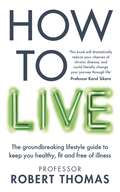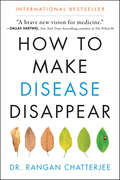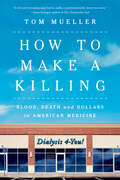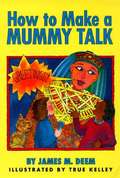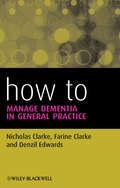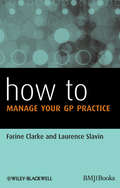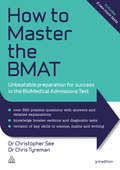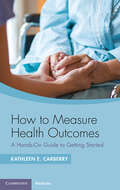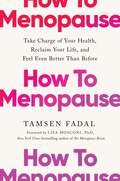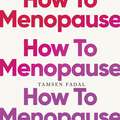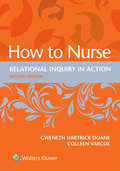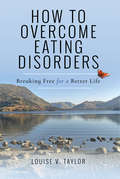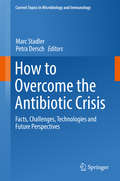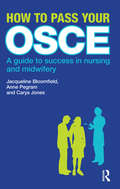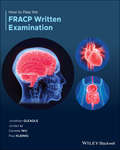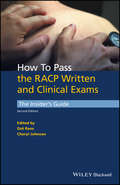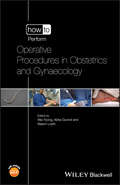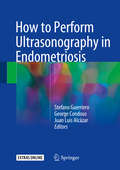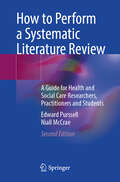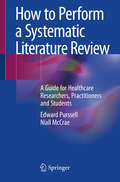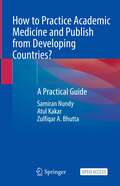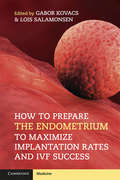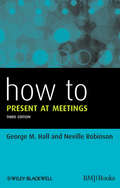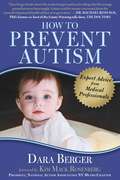- Table View
- List View
How to Live: The groundbreaking lifestyle guide to keep you healthy, fit and free of illness
by Professor Robert ThomasDid you know:· that drinking a glass of red wine after sunbathing can reduce lasting skin damage?· that your choice of deodorant can affect your long-term health?· that some houseplants are more effective in removing air toxins than others?In How to Live, Professor Robert Thomas, one of Britain's leading oncologists and an expert in integrating nutritional and lifestyle strategies into cancer treatment, gives us effective, scientifically proven advice about everything from diet and exercise to sleep and skincare.As Thomas explains, through achievable changes to our daily routine we can improve the expression of our genes - helping us beat the odds of cancer and chronic disease. We discover, for example, why drinking a glass of red wine after sunbathing can reduce lasting skin damage; and why some houseplants are more effective than others in removing air toxins.This is a health bible for life. Whether you are in your 20s or 70s, it will help you to empower your body against ageing and degenerative disease and live at maximum strength.
How to Live: The groundbreaking lifestyle guide to keep you healthy, fit and free of illness
by Professor Robert ThomasDid you know: <P><P>that drinking a glass of red wine after sunbathing can reduce lasting skin damage? <P><P>that your choice of deodorant can affect your long-term health? <P><P>that some houseplants are more effective in removing air toxins than others? <P><P>In How to Live, Professor Robert Thomas, one of Britain's leading oncologists and an expert in integrating nutritional and lifestyle strategies into cancer treatment, gives us effective, scientifically proven advice about everything from diet and exercise to sleep and skincare. <P><P>As Thomas explains, through achievable changes to our daily routine we can improve the expression of our genes - helping us beat the odds of cancer and chronic disease. We discover, for example, why drinking a glass of red wine after sunbathing can reduce lasting skin damage; and why some houseplants are more effective than others in removing air toxins. <P><P>This is a health bible for life. Whether you are in your 20s or 70s, it will help you to empower your body against ageing and degenerative disease and live at maximum strength.
How to Make Disease Disappear
by Rangan ChatterjeeA much-needed program to prevent and reverse disease, and discover a path to sustainable, long-term health from an acclaimed international doctor and star of the BBC program Doctor in the House.How to Make Disease Disappear is Dr. Rangan Chatterjee’s revolutionary, yet simple guide to better health—a much-needed, accessible plan that will help you take back control of your health and your life.A physician dedicated to finding the root cause of ill health rather than simply suppressing symptoms with drugs, Dr. Chatterjee passionately advocates and follows a philosophy that lifestyle and nutrition are first-line medicine and the cornerstone of good health. Drawing on cutting edge research and his own experiences as a doctor, he argues that the secret to preventing disease and achieving wellness revolves around four critical pillars: food, relaxation, sleep, and movement. By making small, incremental changes in each of these key areas, you can create and maintain good health—and alleviate and prevent illness. As Dr. Chatterjee, reveals we can reverse and make disease disappear without a complete overhaul of our lifestyle.His dynamic, user-friendly approach is not about excelling at any one pillar. What matters is balance in every area of your life, which includes:Me-time every dayAn electronic-free Sabbath once a weekRetraining your taste budsDaily micro-fastsMovement snackingA bedtime routinePractical and life-changing, How to Make Disease Disappear is an inspiring and easy-to-follow guide to better health and happiness.
How to Make a Killing: Blood, Death And Dollars In American Medicine
by Tom Mueller“Inspiring and deeply distressing.” —Ezekiel J. Emanuel, author of Which Country Has the World’s Best Health Care? How did a lifesaving medical breakthrough become a for-profit enterprise that threatens many of the people it’s meant to save? Six decades ago, visionary doctors achieved the impossible: the humble kidney, acknowledged since ancient times to be as essential to life as the heart, became the first human organ to be successfully replaced with a machine. Yet huge dialysis corporations, ambitious doctor-entrepreneurs and Beltway lobbyists soon turned this medical miracle into an early experiment in for-profit medicine—and one of the nation’s worst healthcare catastrophes. With powerful insight and on-the-ground reporting, New York Times best-selling author Tom Mueller introduces an unforgettable cast of characters. Heroic patients, including a Hollywood stuntman and body double, risk their lives to blow the whistle on how they’ve been mistreated. An unpaid activist living in a south Georgia trailer park fights to save patients from involuntary discharge from their lifesaving care. Industry insiders put their careers on the line to speak out about the endemic wrongs and pervasive inequality they’ve witnessed—and about dialysis executives who dress as musketeers and Star Wars characters to exhort their employees to more aggressive profit-seeking. Mueller evokes the scientific ingenuity and optimism of the 1950s and 1960s, when the burgeoning field of organ transplant and early dialysis machines offered long-awaited hope for lifesaving care. That is, until a New York salesman had himself dialyzed on the floor of the House, and Congress made renal disease the only “Medicare for All” condition—opening the financial floodgates for Big Dialysis. Of the thousands caught in a web of corporate greed, a disproportionate number are Black and Latino, highlighting the stark racial divides already endemic to American medicine. How to Make a Killing reveals dialysis as a microcosm of American medicine and poses a vital challenge: find a way to fix dialysis, and we’ll have a fighting chance of fixing our country’s dysfunctional healthcare system as a whole, restoring patients, not profits, as its true purpose.
How to Make a Mummy Talk
by James M. DeemIn this funny, fact-filled book, author James M. Deem takes readers on a mummy-discovery tour that spans centuries and continents. He explains exactly what mummies are, how they are created, where they have been found, how scientists investigate them, and what they tell us about the people who lived long ago.
How to Manage Dementia in General Practice (How To)
by Farine Clarke Nicholas Clarke Denzil EdwardsThis practical guide clearly shows each stage in the management of a patient with dementia. It covers the complex issues surrounding dementia such as spouses and families, access to appropriate care, legal and ethical concerns, planning for the future and "living well" and includes the decision making process on initiating treatment and guidance on how best to access the available services.
How to Manage Your GP Practice
by Farine Clarke Laurence SlavinThe business side of running a medical practice may be unappealing but it's crucial How to Manage Your GP Practice is written for GPs and other health professionals running their own practices.It tells you in simple, engaging style what the pitfalls are and how to avoid them.It illustrates the good and bad ways of negotiating through management issues, using case examples and lightening the messages with witty cartoons. Written by a GP with over 10 years' experience editing a leading GP magazine, and an accountant whose firm advises over 2500 GPs, the information here is sound, relevant and up to date. It provides reliable and reassuring information for doctors starting out in their careers as well as those looking to refresh their management skills.
How to Master the BMAT
by Chris John Tyreman Dr Christopher SeeHow to Master the BMAT will help you to maximize your BMAT test score in the shortest time possible with the least possible effort. With over 400 practice questions including six mock tests, it focuses on core knowledge in six key areas: -aptitude and skills -maths -physics -chemistry -biology -writing tasks At the end of each section, a set of review questions enable you to identify and improve your weak areas before you sit the test, then once you are ready you can complete the practice papers that reflect the BMAT test. Candidates are supported throughout the book, and, where possible, every question comes complete with its revision topics indicated in brackets, useful hints and expanded answers.
How to Measure Health Outcomes: A Hands-On Guide to Getting Started
by Kathleen E. CarberryComplementing existing literature on measuring health outcomes that is largely conceptual, this book focuses on simple, practical advice for measuring outcomes in a variety of settings. Written in an engaging conversational tone, readers will learn why measuring health outcomes is necessary in clinical practice and how these measures may vary between people and across care structures. Covering how to identify measurements as well as collect and analyze the data, the chapters lead readers through a series of logical steps to scaling up a measurement program. The workbook style allows readers to record their own notes and thoughts throughout the book, while the list of action steps at the end of chapters are tangible starting points for developing a measurement program of their own. Explores how to measure and think about outcomes in a way that sees the whole person, not just the medical or behavioral condition they have.
How to Menopause: Take Charge of Your Health, Reclaim Your Life, and Feel Even Better than Before
by Tamsen FadalEXPERT-DRIVEN, GIRLFRIEND-APPROVED - The menopause manual that cuts through the chaos so you can take back control of your body, your confidence, and your life, from Emmy award-winning journalist, documentary filmmaker, and social media powerhouse Tamsen Fadal.What's happening to me? Is anyone else feeling this way? Why did no one tell me about this?If you're ready to feel like yourself again, this book is "the talk" you never had.How To Menopause is packed with actionable steps and evidence-based tools from a team of 42 experts including neuroscientists, menopause-certified physicians, sex and relationship therapists, sleep doctors, and a variety of lifestyle mentors.Synthesizing research, stories, and strategies in a way that only an investigative journalist can, Tamsen Fadal helps you- be your best advocate in a medical system not designed to treat women in midlife,- understand the options that tame your symptoms, whether it's hormone therapy, supplements, or lifestyle changes,- have science-backed strategies to get the best sleep of your life,- be able to talk to your partner about sex, low libido, painful intercourse, or how your hormones might be impacting your relationship,- update your style (hair, makeup, clothes) to match your changing body,- learn simple workouts, skincare tips, and delicious recipes to deal with belly fat, dry skin, and hair loss (and don't worry, it's not all kale salads)--and much, much more.How to Menopause answers all the questions you've been too nervous to ask, and brings you into a conversation with millions of other women. Together, we can embrace a stronger, sexier self at every stage of midlife-from perimenopause through menopause and into our "bolden" years."How to Menopause is more than just advice--it provides a lifeline. Through her honesty, humor, research, and relentless commitment to women's health, Tamsen Fadal has created a guide that is both practical and deeply personal. Whether you're just beginning to experience perimenopause or well into this transition, these words will leave you feeling more confident, more informed, and most importantly--never alone." --Lisa Mosconi, PhD, New York Times bestselling author of The Menopause Brain
How to Menopause: Take Charge of Your Health, Reclaim Your Life, and Feel Even Better than Before
by Tamsen FadalEXPERT-DRIVEN, GIRLFRIEND-APPROVED - The menopause manual that cuts through the chaos so you can take back control of your body, your confidence, and your life, from Emmy award-winning journalist, documentary filmmaker, and social media powerhouse Tamsen Fadal.What's happening to me? Is anyone else feeling this way? Why did no one tell me about this?If you're ready to feel like yourself again, this book is "the talk" you never had.How To Menopause is packed with actionable steps and evidence-based tools from a team of 42 experts including neuroscientists, menopause-certified physicians, sex and relationship therapists, sleep doctors, and a variety of lifestyle mentors.Synthesizing research, stories, and strategies in a way that only an investigative journalist can, Tamsen Fadal helps you- be your best advocate in a medical system not designed to treat women in midlife,- understand the options that tame your symptoms, whether it's hormone therapy, supplements, or lifestyle changes,- have science-backed strategies to get the best sleep of your life,- be able to talk to your partner about sex, low libido, painful intercourse, or how your hormones might be impacting your relationship,- update your style (hair, makeup, clothes) to match your changing body,- learn simple workouts, skincare tips, and delicious recipes to deal with belly fat, dry skin, and hair loss (and don't worry, it's not all kale salads)--and much, much more.How to Menopause answers all the questions you've been too nervous to ask, and brings you into a conversation with millions of other women. Together, we can embrace a stronger, sexier self at every stage of midlife-from perimenopause through menopause and into our "bolden" years."How to Menopause is more than just advice--it provides a lifeline. Through her honesty, humor, research, and relentless commitment to women's health, Tamsen Fadal has created a guide that is both practical and deeply personal. Whether you're just beginning to experience perimenopause or well into this transition, these words will leave you feeling more confident, more informed, and most importantly--never alone." --Lisa Mosconi, PhD, New York Times bestselling author of The Menopause Brain
How to Nurse: Relational Inquiry in Action
by Colleen Varcoe Gweneth Hartrick DoaneConfidently address the theory-to-practice gap and equip your students with a theoretically sound, research-informed approach to successful nursing practice. How to Nurse: Relational Inquiry in Action, Second Edition, focuses on the “how” of relational inquiry to demonstrate the relevance of nursing research and help students confidently navigate the complexities of real-life nursing practice. A conversational writing style makes concepts accessible and engaging learning tools link conceptual ideas to clinical action to prepare your students for safe, competent nursing practice. UPDATED! Revised content reflects the most current practices informed by the latest evidence-based research. NEW! Relational Inquiry Toolbox features highlight knowledge, strategies, inquiry frameworks and checkpoints to strengthen your everyday nursing practice. To Illustrate features reinforce key concepts with real-life examples of patients and families, former students, practice nurses and clinical nurse specialists. Try it Out activities challenge you to engage with chapter content and apply concepts in a range of ways. Text Boxes summarize essential relational inquiry ideas and strategies at a glance. Figures and Images clarify the relationship between ideas and stimulate your critical thinking capabilities. Learning Objectives help you prioritize chapter content and make the most of your study. An Example stories illustrate key points in the text.
How to Overcome Eating Disorders: Breaking Free for a Better Life
by Louise V. TaylorIf you want to gain a better understanding of eating disorders, including anorexia, bulimia and binge eating disorder, this book is for you. It looks at theories about the causes of eating disorders, including susceptibility studies, personality traits, genetics, the effects of personal circumstances, societal/media pressures, family influences and more.The health risks are covered and the damage caused by eating disorders is made clear. This information, especially, will help some sufferers find the strength and determination to fight their disease and break free.The book explains the logic of eating disordered individuals, with some using food or weight control as a coping mechanism to block out painful emotions. It will enable the reader to better understand why some people with eating disorders behave as they do.It looks at the latest research, and new and emerging treatments are discussed, as well as established treatments and their success rates. In addition to conventional treatments medical, psychological and therapeutic the book considers complimentary therapies that may support an individual's recovery.It also includes nutritional information, to help those who are frightened of food, because they feel out of control around it, or are afraid of being overweight. There is a chapter on adjusting to change, recovery strategies and a look at why pro-ana communities are unhelpful, suggesting healthier social groups and past-times.The book contains extensive case studies of people who have battled with anorexia and bulimia, looking at some of the things that may have played a role in their disease, such as abuse, bullying, loneliness, low self-esteem, unhappiness and pressures to conform.
How to Overcome the Antibiotic Crisis
by Marc Stadler Petra DerschThis volume focuses on antibiotics research, a field of topical significance for human health due to the worrying increase of nosocomial infections caused by multi-resistant bacteria. It covers several basic aspects, such as the evolution of antibiotic resistance and the influence of antibiotics on the gut microbiota, and addresses the search for novel pathogenicity blockers as well as historical aspects of antibiotics. Further topics include applied aspects, such as drug discovery based on biodiversity and genome mining, optimization of lead structures by medicinal chemistry, total synthesis and drug delivery technologies. Moreover, the development of vaccines as a valid alternative therapeutic approach is outlined, while the importance of epidemiological studies on important bacterial pathogens, the problems arising from the excessive use of antibiotics in animal breeding, and the development of innovative technologies for diagnosing the "bad bugs" are discussed in detail. Accordingly, the book will appeal to researchers and clinicians alike.
How to Pass Your OSCE: A Guide to Success in Nursing and Midwifery
by Carys Jones Jacqueline Bloomfield Anne PegramThe Objective Structured Clinical Examination (OSCE) was developed for all undergraduate nursing programmes, with the aim of emphasising the need for nursing students to be competent in clinical skills, to assess clinical reasoning skills and as a means of standardizing the assessment process. This practical, easy to read and interactive study guide helps nursing and midwifery students at all levels to maximise their chances of success with OSCEs. It features case studies, quick quizzes, recap and recall summaries and an OSCE preparation plan; all of which help to prepare the student for the examination. Hints and tips on what to expect during the examination and pointers on what the examiner will be looking for, together with a comprehensive chapter on personal learning will help to guide the student through the process and maximise their chances of success!"Very readable with useful tips and information for students" Cath Hill, Keele University"I found the book extremely relevant from the students' perspective, reader friendly and well structured. Quizzes and activities excellent." - Liz Day, Senior Lecturer, Nursing and Health Care Practice, University of Derby "A useful and easily digested text on this important assessment strategy", Ms. Karen Lumsden, Faculty of Nursing and Applied Clinical Studies, Canterbury Christchurch University"Useful for students as they prepare... Easy to read and understand."Kirsty Wedgbury, Faculty of Health and Community Care, Birmingham City University
How to Pass the FRACP Written Examination
by Danielle Wu Jonathan Gleadle Jordan Li Paul KleinigHow to Pass the FRACP Written Examination is an indispensable review and study guide for anyone preparing for the challenging Fellow of the Royal Australasian College of Physicians (FRACP) exam. This up-to-date resource fully aligns with the current FRACP core training curriculum, containing a wealth of traditional multiple-choice questions (MCQs) as well as extended-matching questions (EMQs). There are hundreds of questions for every major topic of the written examination, including critical care medicine, cardiology, infectious diseases, immunology and allergy, neurology, and pharmacology. More than a simple practice exam, this guide provides clear and complete explanations of each answer, a mini-review of the subject, and links to the most recent or relevant articles on the topic. Complementing the main body of questions are a number of ‘teaching’ and two-step questions—designed to strengthen clinical reasoning skills, highlight important issues, and expand knowledge of contemporary ‘hot’ topics. Written by an experienced team of physicians and educators, this must-have book: Provides a thorough review of the latest FRACP basic training syllabus Features QR codes embedded in the text to enable quick access to all references Offers tips, hints, advice, and examination strategies from previous candidates Provides numerous questions grounded in clinically relevant cases Covers of areas of medicine that are new, contemporary, and evolving Covering both the ‘Basic Sciences’ and ‘Clinical Practice’ of the latest exam, Passing the FRACP Written Examination is an essential companion for FRACP candidates as well as those looking to refresh, improve, or update their knowledge of the FRACP syllabus.
How to Pass the RACP Written and Clinical Exams: The Insider's Guide
by Cheryl Johnson Zoë RaosSurviving the journey through the Royal Australasian College of Physicians (RACP) examinations requires grit, courage and hard work. The second edition of How To Pass the RACP Written and Clinical Exams is fully updated to help candidates – and those who teach them – dig deep to maximise their chances of success. This insider’s guide takes the candidate through the whole process, from preparing for the Written Exam, through to presenting short and long cases in the Clinical Exam. The authors’ experiences are combined with tips from recent candidates, wisdom from RACP examiners and advice from specialist contributors. Additional chapters for post-exam registrars and supervisors include career planning, providing feedback, preparing for interviews, and organising the Clinical Exam. As well as comprehensive guidance for adult medicine candidates, this new edition includes ‘Paeds Points’ for paediatrics trainees. Containing a wealth of information, pearls of wisdom, real-life examples and practical advice, this light-hearted insider’s guide makes the path through the grueling RACP exams far easier.
How to Perform Operative Procedures in Obstetrics and Gynaecology (How to Perform)
by Wai Yoong Wasim Lodhi Abha GovindTrainees in Obstetrics and Gynaecology require robust operative skills, yet factors such as the implementation of structured training and increased litigation concerns have significantly limited training time. Whilst conventional textbooks are sufficient for presenting theoretical knowledge, they are inadequate in explaining practical procedures. How to Perform Operative Procedures in Obstetrics and Gynaecology thoroughly describes many key index operations in the Royal College of Obstetricians and Gynaecologists training syllabus, offering an innovative, media-rich approach to the subject. Written by a team of O&G practitioners, this unique resource combines concise written instructions, full-colour pictures and diagrams, and hours of high-quality video footage of real-life operations, narrated by experienced NHS consultants. Specialty trainees, MRCOG candidates and post-MRCOG doctors are provided clear, easy-to-follow guidance on procedures including assisted vaginal delivery, Caesarean section, abdominal hysterectomy, diagnostic and operative laparoscopy, cone biopsy, rigid cystoscopy and many others. Features a companion website containing more than six hours of video tutorials, vignettes and personal experiences Includes a colour WHO Surgical Safety Checklist Discusses non-technical aspects such as consent and understanding human factors Covers surgical instruments, surgical positioning, and sutures and needles Offers introductions, overviews, and “Top Tips” for each procedure to highlight important learning points An ideal study guide and reference for individual and group work alike, How to Perform Operative Procedures in Obstetrics and Gynaecology is indispensable for specialty trainees and those preparing for MRCOG examinations.
How to Perform Ultrasonography in Endometriosis
by Stefano Guerriero George Condous Juan Luis AlcázarThis structured dynamic book outlines, step by step, an evidence-based systematic approach to the sonographic evaluation of the pelvis in women with suspected endometriosis. This “how to” guide is intended for those with basic ultrasonography skills who want to further develop their capabilities in performing the relevant sonographic techniques to identify endometriosis. Detailed schematics, and corresponding high-resolution ultrasound images and intuitive videos support readers in expanding their technical skills and bridging the gaps in their knowledge of endometriosis ultrasound. The International Deep Endometriosis Analysis (IDEA) group consensus statement was the culmination of the work of 29 authors from 5 continents. With the publication of How to Perform Ultrasonography in Endometriosis the authors intend to provide the basis for quality improvement and benchmarking of ultrasound in the world of endometriosis. This book not only offers sonologists, radiologists and sonographers valuable insights into the field of endometriosis ultrasound, but also enables them to develop their practical skills in assessing women with chronic pelvic pain.
How to Perform a Systematic Literature Review: A Guide for Health and Social Care Researchers, Practitioners and Students
by Niall McCrae Edward PurssellThis new edition is an authoritative and accessible textbook to an activity that is often found overwhelming. The systematic review is a rigorous method of collating and synthesizing evidence from multiple studies, producing a whole greater than the sum of parts. The authors steer readers on a logical path through the process, taking account of the different needs of researchers, students and practitioners in health and social care. Practical guidance is provided on the fundamentals of systematic reviewing and also on advanced techniques such as meta-analysis. Examples are given throughout, with a succinct glossary to support the text. This new edition updates the first edition by considering a range of new and emerging issues in the systematic review process. In particular: • The need for evidence to be systematically appraised in a timely manner, particularly during public health emergencies and when urgent patient care issues are being considered. • The balance between speed and comprehensiveness. • New and developing areas of interest, such as living reviews and rapid reviews, both of which increased during Covid-19. • Advances in methodologies, and in particular meta-analysis methods • The introduction of AI and other automated processes of data management This up-to-date, accessible textbook will satisfy the needs of students, practitioners and educators in the sphere of health and social care. The authors will advise some freely available or inexpensive open source/access resources (such as PubMed, R and Zotero) to help students how to perform a systemic review and to see how this informs the guideline and decision making process.
How to Perform a Systematic Literature Review: A Guide for Healthcare Researchers, Practitioners and Students
by Niall McCrae Edward PurssellThe systematic review is a rigorous method of collating and synthesizing evidence from multiple studies, producing a whole greater than the sum of parts. This textbook is an authoritative and accessible guide to an activity that is often found overwhelming. The authors steer readers on a logical, sequential path through the process, taking account of the different needs of researchers, students and practitioners. Practical guidance is provided on the fundamentals of systematic reviewing and also on advanced techniques such as meta-analysis. Examples are given in each chapter, with a succinct glossary to support the text. This up-to-date, accessible textbook will satisfy the needs of students, practitioners and educators in the sphere of healthcare, and contribute to improving the quality of evidence-based practice. The authors will advise some freely available or inexpensive open source/access resources (such as PubMed, R and Zotero) to help students how to perform a systemic review, in particular those with limited resources.
How to Practice Academic Medicine and Publish from Developing Countries?: A Practical Guide
by Samiran Nundy Atul Kakar Zulfiqar A. BhuttaThis is an open access book. The book provides an overview of the state of research in developing countries – Africa, Latin America, and Asia (especially India) and why research and publications are important in these regions. It addresses budding but struggling academics in low and middle-income countries. It is written mainly by senior colleagues who have experienced and recognized the challenges with design, documentation, and publication of health research in the developing world. The book includes short chapters providing insight into planning research at the undergraduate or postgraduate level, issues related to research ethics, and conduct of clinical trials. It also serves as a guide towards establishing a research question and research methodology. It covers important concepts such as writing a paper, the submission process, dealing with rejection and revisions, and covers additional topics such as planning lectures and presentations. The book will be useful for graduates, postgraduates, teachers as well as physicians and practitioners all over the developing world who are interested in academic medicine and wish to do medical research.
How to Prepare the Endometrium to Maximize Implantation Rates and IVF Success
by Gabor Kovacs Lois SalamonsenThe last step in the IVF treatment cycle, embryo transfer, is also the process with the highest failure rate. No matter how good the laboratory technique is, a successful pregnancy will not be achieved without meticulous preparation of the uterus to accept the embryo. This book reviews the scientific evidence on endometrial receptivity, including histological, hormonal, biochemical, and immunological factors. Practical and concise, it supports gynecologists and embryologists to make evidence-based decisions that can influence the success rates of implantation and live births. Part of a series of books offering treatments and strategies for fertility and conception to optimize IVF outcomes, this volume is for all clinicians and embryologists working in reproductive medicine.
How to Present at Meetings (How To #33)
by Neville Robinson George M. HallDoes the thought of presenting a paper make you go cold? There are so many things to consider: getting your message across clearly, making the PowerPoint easy to read, keeping to the right length and keeping the audience riveted – enough to induce nerves even without the thought of standing up in front of a crowd and delivering your talk fluently. How to Present at Meetings, 3rd Edition, gives you practical advice on all these aspects, and more. Written by high-profile public speakers in the health sciences, it includes chapters on the 10-, 20- and 45-minute presentation, how not to make a mess of PowerPoint, and how to appear on stage.
How to Prevent Autism: Expert Advice from Medical Professionals
by Scott Smith Katie Wright James Lyons-Weiler Kim Mack Rosenberg Dara Berger Dr Sidney Baker Dr Nancy O'Hara Geri Brewster Maureen McDonnel Dr Anju Usman Dr Stephanie Seneff Maria Rickert-Hong Corinne Simpson BrownThe statistics are alarming and become more so every year. The Centers for Disease Control and Prevention estimates that 1 in 68 children have been identified with an autism spectrum disorder, making it one of the fastest growing developmental disorders in the United States. Further, the CDC estimates that parents with a child on the autism spectrum can have nearly a 20 percent chance of having a second child with autism.In How to Prevent Autism, Dara Berger shares her personal journey with autism. She describes everything that went wrong with her son that led to an autism diagnosis and everything she did differently to prevent her daughter from suffering the same fate. She interviews eight well-known ASD experts--including doctors, nutritionists, nurses, and scientists--about the factors that have led to the growing epidemic of autism. Based on the best practices for preventing autism in children, each professional offers perspectives grounded in their own research and their patients’ improvements. The book covers every detail--from the importance of mothers’ cleaning out their bodies preconception, through common genetic mutations that may put children at risk, to the crucial role of nutrition in prevention.All parents agree that every choice counts when it comes to the health of their children. As Dara Berger makes clear in this personal, informative, and authoritative book, the stakes could not be higher when it comes to autism.
